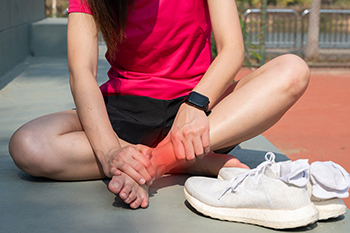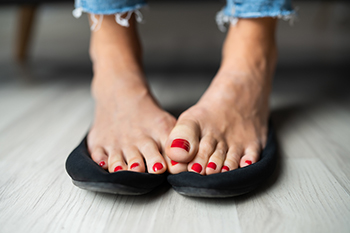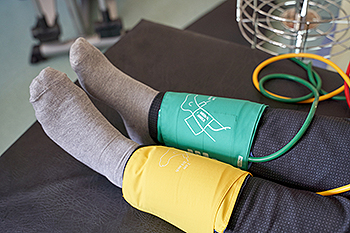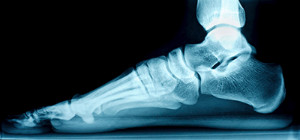Items filtered by date: December 2023
Facts About Foot and Ankle Sports Injuries

Sports enthusiasts, whether seasoned athletes or weekend warriors, often face the risk of foot and ankle injuries. These injuries are broadly categorized into acute and chronic, each with its unique characteristics. Acute injuries strike suddenly, resulting from falls, blows, or joint twists. Sprained ankles and dislocations are common examples. Conversely, chronic injuries develop gradually due to overuse. Conditions like foot or heel stress fractures fall into this category, often arising from repetitive strain on specific body areas. Several risk factors contribute to these injuries, including incorrect exercise techniques, overtraining, and sudden intensity changes. Running or jumping on hard surfaces, inadequate shoe support, and improper equipment use can also play a role. Further, prior injuries, specifically biomechanical features such as flat feet or bunions can increase the risk of injury. In addition, factors like age, sex, and the nature of physical activity determine one's susceptibility to specific injuries. For help with any sports related foot or ankle injuries, it is suggested that you schedule an appointment with a podiatrist for an exam and treatment options.
Sports related foot and ankle injuries require proper treatment before players can go back to their regular routines. For more information, contact Paul A. Santangelo, DPM of Illinois. Our doctor can provide the care you need to keep you pain-free and on your feet.
Sports Related Foot and Ankle Injuries
Foot and ankle injuries are a common occurrence when it comes to athletes of any sport. While many athletes dismiss the initial aches and pains, the truth is that ignoring potential foot and ankle injuries can lead to serious problems. As athletes continue to place pressure and strain the area further, a mild injury can turn into something as serious as a rupture and may lead to a permanent disability. There are many factors that contribute to sports related foot and ankle injuries, which include failure to warm up properly, not providing support or wearing bad footwear. Common injuries and conditions athletes face, including:
- Plantar Fasciitis
- Plantar Fasciosis
- Achilles Tendinitis
- Achilles Tendon Rupture
- Ankle Sprains
Sports related injuries are commonly treated using the RICE method. This includes rest, applying ice to the injured area, compression and elevating the ankle. More serious sprains and injuries may require surgery, which could include arthroscopic and reconstructive surgery. Rehabilitation and therapy may also be required in order to get any recovering athlete to become fully functional again. Any unusual aches and pains an athlete sustains must be evaluated by a licensed, reputable medical professional.
If you have any questions please feel free to contact our offices located in Niles and Rockford, IL . We offer the newest diagnostic and treatment technologies for all your foot and ankle needs.
Sweating of the Feet

Hyperhidrosis is characterized by excessive sweating at any time. The two main types are primary focal hyperhidrosis and secondary generalized hyperhidrosis. Distinguishing them is vital for proper care. Primary focal hyperhidrosis often starts in childhood and is possibly linked to genetics. It results in localized sweating in areas like the feet. Regardless of activity or temperature, excessive sweating occurs, impacting daily life and possibly causing skin issues. Secondary generalized hyperhidrosis is typically diagnosed later in life and may relate to other health conditions or medications. Sweating affects the entire body, including night sweats, unrelated to exercise or anxiety. Complications of hyperhidrosis can include social and emotional challenges, such as embarrassment, social isolation, and anxiety. Psychological impacts affect confidence, work performance, and relationships. Skin related issues like maceration and fungal infections are common due to continuous moisture. If you or your child suffers from hyperhidrosis of the feet, it is suggested that you schedule an appointment with a podiatrist for a diagnosis so that appropriate treatment can be administered, and possible complications can be avoided.
If you are suffering from hyperhidrosis contact Paul A. Santangelo, DPM of Illinois. Our doctor can provide the care you need to attend to all of your foot and ankle needs.
Hyperhidrosis of the Feet
Hyperhidrosis is a rare disorder that can cause people to have excessive sweating of their feet. This can usually occur all on its own without rigorous activity involved. People who suffer from hyperhidrosis may also experience sweaty palms.
Although it is said that sweating is a healthy process meant to cool down the body temperature and to maintain a proper internal temperature, hyperhidrosis may prove to be a huge hindrance on a person’s everyday life.
Plantar hyperhidrosis is considered to be the main form of hyperhidrosis. Secondary hyperhidrosis can refer to sweating that occurs in areas other than the feet or hands and armpits. Often this may be a sign of it being related to another medical condition such as menopause, hyperthyroidism and even Parkinson’s disease.
In order to alleviate this condition, it is important to see your doctor so that they may prescribe the necessary medications so that you can begin to live a normal life again. If this is left untreated, it is said that it will persist throughout an individual’s life.
A last resort approach would be surgery, but it is best to speak with your doctor to find out what may be the best treatment for you.
If you have any questions please feel free to contact our offices located in Niles and Rockford, IL . We offer the newest diagnostic and treatment technologies for all your foot and ankle needs.
Risk Factors for Peripheral Artery Disease

Peripheral arterial disease, or PAD, is a vascular condition characterized by narrowed arteries in the legs, limiting blood flow to the feet. Several risk factors contribute to the development and progression of PAD. Smoking is a primary risk factor, as it damages blood vessels and promotes plaque buildup. Diabetes is another significant factor, as high blood sugar levels can damage arteries. Hypertension, or high blood pressure, places constant stress on arteries and can lead to their narrowing over time. Age is also a non-modifiable risk factor, as PAD becomes more common with advancing age. Genetics can play a role, with a family history of vascular diseases increasing one's susceptibility. Obesity and a sedentary lifestyle contribute by promoting the accumulation of fatty deposits in arteries. Additionally, high cholesterol levels can lead to plaque formation in blood vessels. Lastly, individuals with a history of heart disease are at higher risk for PAD. If you have risk factors for PAD or suffer from its effects on your feet, it is suggested that you schedule an appointment with a podiatrist for an examination and necessary treatment.
Peripheral artery disease can pose a serious risk to your health. It can increase the risk of stroke and heart attack. If you have symptoms of peripheral artery disease, consult with Paul A. Santangelo, DPM from Illinois. Our doctor will assess your condition and provide you with quality foot and ankle treatment.
Peripheral artery disease (PAD) is when arteries are constricted due to plaque (fatty deposits) build-up. This results in less blood flow to the legs and other extremities. The main cause of PAD is atherosclerosis, in which plaque builds up in the arteries.
Symptoms
Symptoms of PAD include:
- Claudication (leg pain from walking)
- Numbness in legs
- Decrease in growth of leg hair and toenails
- Paleness of the skin
- Erectile dysfunction
- Sores and wounds on legs and feet that won’t heal
- Coldness in one leg
It is important to note that a majority of individuals never show any symptoms of PAD.
Diagnosis
While PAD occurs in the legs and arteries, Podiatrists can diagnose PAD. Podiatrists utilize a test called an ankle-brachial index (ABI). An ABI test compares blood pressure in your arm to you ankle to see if any abnormality occurs. Ultrasound and imaging devices may also be used.
Treatment
Fortunately, lifestyle changes such as maintaining a healthy diet, exercising, managing cholesterol and blood sugar levels, and quitting smoking, can all treat PAD. Medications that prevent clots from occurring can be prescribed. Finally, in some cases, surgery may be recommended.
If you have any questions, please feel free to contact our offices located in Niles and Rockford, IL . We offer the newest diagnostic and treatment technologies for all your foot care needs.
Do Your Child's Feet Hurt?
Recognizing the Symptoms of Flat Feet

Flat feet, or fallen arches, are a common condition where the arches of the feet collapse, causing the entire sole to touch the ground. Recognizing the symptoms of flat feet is essential for understanding and addressing this condition. One prevalent sign is pain or discomfort along the inner side of the ankle and arch. Individuals with flat feet may also experience swelling along the inside of the ankle. The lack of a visible arch when standing or walking is a visual indicator of flat feet. Overpronation, where the foot rolls inward excessively, can contribute to this condition and lead to related issues, including shin splints or knee pain. Fatigue and aching in the feet and legs can occur, especially after prolonged standing. If you have flat feet, it is suggested that you speak to a podiatrist who can provide you with effective relief options.
Flatfoot is a condition many people suffer from. If you have flat feet, contact Paul A. Santangelo, DPM from Illinois. Our doctor will treat your foot and ankle needs.
What Are Flat Feet?
Flatfoot is a condition in which the arch of the foot is depressed and the sole of the foot is almost completely in contact with the ground. About 20-30% of the population generally has flat feet because their arches never formed during growth.
Conditions & Problems:
Having flat feet makes it difficult to run or walk because of the stress placed on the ankles.
Alignment – The general alignment of your legs can be disrupted, because the ankles move inward which can cause major discomfort.
Knees – If you have complications with your knees, flat feet can be a contributor to arthritis in that area.
Symptoms
- Pain around the heel or arch area
- Trouble standing on the tip toe
- Swelling around the inside of the ankle
- Flat look to one or both feet
- Having your shoes feel uneven when worn
Treatment
If you are experiencing pain and stress on the foot you may weaken the posterior tibial tendon, which runs around the inside of the ankle.
If you have any questions please feel free to contact our offices located in Niles and Rockford, IL . We offer the newest diagnostic and treatment technologies for all your foot and ankle needs.

